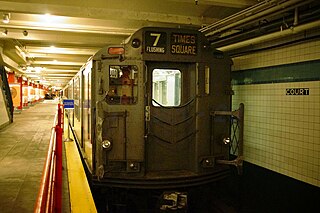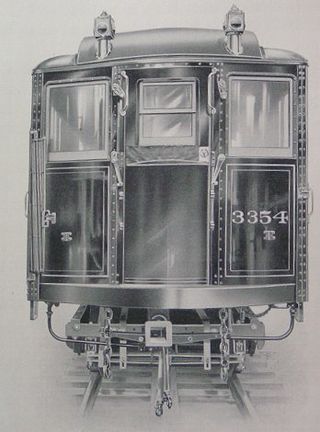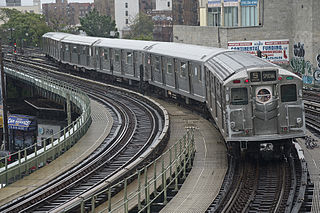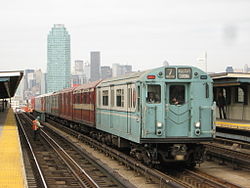
The Interborough Rapid Transit Company (IRT) was the private operator of New York City's original underground subway line that opened in 1904, as well as earlier elevated railways and additional rapid transit lines in New York City. The IRT was purchased by the city in June 1940, along with the younger BMT and IND systems, to form the modern New York City Subway. The former IRT lines are now the A Division or IRT Division of the Subway.

The New York City Subway is a large rapid transit system and has a large fleet of electric multiple unit rolling stock. As of November 2016, the New York City Subway has 6418 cars on the roster.

Redbird trains were eight New York City Subway train models so-nicknamed because of their red paint. The Redbirds totaled 1,410 cars of the following types on the A Division lines: R26, R28, R29, R33, R33S, and R36. There were also 550 cars on the B Division lines: R27 and R30/A. All were built by the American Car and Foundry Company and the St. Louis Car Company.

The R33S was a New York City Subway car that was built by St. Louis Car Company in 1963 for the IRT A Division. They were purchased for service on the IRT Flushing Line, which was the closest line to the 1964 New York World's Fair. A total of 40 cars were built, arranged as single cars. While in regular service, each R33S was coupled to five two-car consists of R36 cars to make 11-car trains for the 7 and <7> routes.

The R36 was a New York City Subway car model built by the St. Louis Car Company from 1963 to 1964. The cars are a "follow-up" or supplemental stock to the A Division's R33s, which some of the cars closely resemble. A total of 424 cars were built, arranged in pairs. The order includes World's Fair cars comprising 390 cars, and Main Line cars comprising 34 cars.

The New York Transit Museum is a museum that displays historical artifacts of the New York City Subway, bus, and commuter rail systems in the greater New York City metropolitan region. The main museum is located in the decommissioned Court Street subway station in Downtown Brooklyn and Brooklyn Heights in the New York City borough of Brooklyn. There is a smaller satellite Museum Annex in Grand Central Terminal in Midtown Manhattan. The museum is a self-supporting division of the Metropolitan Transportation Authority.

New York City Subway nomenclature is the terminology used in the New York City Subway system as derived from railroading practice, historical origins of the system, and engineering, publicity, and legal usage. Important terms include lines, or individual sections of subway, like the BMT Brighton Line; services, like the B, which is a single train route along several lines; and stations, such as Coney Island–Stillwell Avenue, which connects multiple lines and services.

The R10 was the first series of post-war New York City Subway cars. They were built by the American Car and Foundry Company from 1948 to 1949 for the IND/BMT B Division. A total of 400 cars were built, arranged as single units. Two versions were manufactured: Westinghouse (WH)-powered cars and General Electric (GE)-powered cars. The R10s introduced many innovations, including an all-welded low-alloy high tensile (LAHT) steel construction, dynamic braking, improved propulsion, and various cosmetic features.

The R12 was a New York City Subway car built by the American Car and Foundry Company in 1948. A total of 100 cars were built, arranged as single units. Two versions were manufactured: Westinghouse (WH)-powered cars and General Electric (GE)-powered cars.

The R33 was a New York City Subway car model that was built by St. Louis Car Company in 1962 and 1963. The cars are a "follow-up" or supplemental stock for the A Division's R29s and closely resemble them. The cars were also referred to as R33MLs to distinguish them from the R33Ss. A total of 500 cars were built, numbered 8806–9305, and arranged in pairs.

The R27 was a New York City Subway car model built by the St. Louis Car Company from 1960 to 1961 for the IND/BMT B Division. A total of 230 cars were built, arranged in married pairs. Two versions were manufactured: Westinghouse (WH)-powered cars and General Electric (GE)-powered cars.

The R30 was a New York City Subway car model built by St. Louis Car Company from 1961 to 1962. The cars were a "follow-up" or supplemental stock for the B Division's R27s and closely resembled them. A total of 320 cars were built, arranged in married pairs. Three versions were manufactured: Westinghouse (WH)-powered cars, General Electric (GE)-powered cars, and R30As.

The Central Park North–110th Street station is a station on the IRT Lenox Avenue Line of the New York City Subway, located at the intersection of 110th Street and Lenox Avenue at the southern edge of Harlem, Manhattan. It is served by the 2 and 3 trains at all times.

The R14 was a New York City Subway car model built by the American Car and Foundry Company in 1949. The cars were a "follow-up" or supplemental stock for the A Division's R12s and look exactly the same, differing only in floor patterns. A total of 150 cars were built, arranged as single units. Two versions were manufactured: Westinghouse (WH)-powered cars and General Electric (GE)-powered cars.

The R15 was a New York City Subway car model built by the American Car and Foundry Company in 1950 for the IRT A Division. A total of 100 cars were built, arranged as single units. Two versions were manufactured: Westinghouse (WH)-powered cars and General Electric (GE)-powered cars.

The R17 was a New York City Subway car model built by the St. Louis Car Company in 1954 for the IRT A Division. A total of 400 cars were built, arranged as single units. Two versions were manufactured: Westinghouse (WH)-powered cars and General Electric (GE)-powered cars.

The Q-type and QX were a New York City Subway car class originally built by the Osgood-Bradley, Brill, Laconia, and Jewett car companies, and rebuilt in 1938 by the Brooklyn–Manhattan Transit Corporation (BMT) from former BU cars.

The Deck Roof Hi-V was a New York City Subway car class built from 1907 to 1908 by the American Car and Foundry for the IRT and its successors, the New York City Board of Transportation and the New York City Transit Authority.

The Gibbs Hi-V was a New York City Subway car class built from 1904 to 1905 by American Car and Foundry for the IRT and its successors, the New York City Board of Transportation and the New York City Transit Authority. It was the first all-steel subway car ordered for New York City.

The Train of Many Metals is one of the New York Transit Museum's nostalgia trains used for excursions on the B Division. The name refers to most of the cars that were preserved being constructed from steel, and in reference to the Train of Many Colors.



















